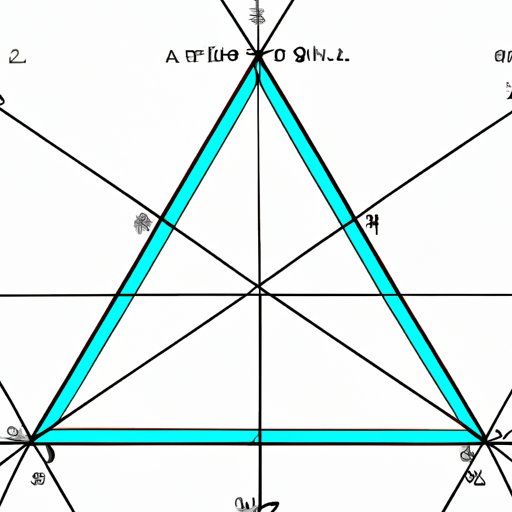I. Introduction
When it comes to understanding the behavior of graphs and functions, the concept of the axis of symmetry plays a critical role. The axis of symmetry is a vertical line that divides a parabola into two halves that are mirror images of each other. In other words, it is the line that passes through the vertex of a parabola and divides it into two congruent halves. In this article, we will explore how to find the axis of symmetry and why it is essential to know how to do so.
II. Understanding the Formula
The formula for finding the axis of symmetry for a parabolic equation in standard form is (-b/2a). Here, a and b are coefficients of x^2 and x, respectively. This formula can be derived from the vertices of the parabola, which is the highest or lowest point of the graph. By definition, the axis of symmetry is a vertical line that passes through the vertex of a parabola. Hence, the x-coordinate of the axis of symmetry is equal to the vertex’s x-coordinate, which is (-b/2a).
To understand this concept mathematically, let us take the equation y = 2x^2 + 4x + 1. Here, a = 2 and b = 4. By substituting the formula, we can calculate:
Axis of Symmetry = -b/2a = -4/4 = -1
Therefore, the axis of symmetry for the given quadratic equation is x = -1. By plotting the graph and drawing a vertical line through x=-1, the parabolic curve will be divided into two equal, congruent halves.
III. Exploring Vertex Identification
Before we learn how to find the axis of symmetry, it is essential to identify the vertex of a parabolic curve. The vertex is the highest or lowest point on the curve and is located at the intersection of the axis of symmetry and the parabola. To identify the vertex, we can follow these steps:
- Rewrite the equation in vertex form by completing the square.
- Identify the vertex as (h, k), where h is the x-coordinate and k is the y-coordinate of the vertex.
For example, let’s consider the quadratic equation y = 3x^2 + 6x – 1. First, we can rewrite the equation as y=3(x+1)^2-4, which gives the vertex as (-1,-4).
IV. Step-by-Step Process for Finding Axis of Symmetry
Now that we can identify the vertex of a parabolic equation let’s explore the process of how to find the axis of symmetry. To do this, we need to follow these essential steps:
- Identify the equation in standard form.
- Identify the values of a and b.
- Substitute a and b into the formula, (-b/2a).
- Simplify the equation to determine the x-coordinate of the axis of symmetry.
- Write the equation of the axis of symmetry as x= (x-coordinate of the vertex).
For example, suppose the quadratic equation is y = -2x^2 + 8x + 3. By substituting a=-2 and b=8 into the formula, we get :
Axis of Symmetry = -b/2a = -8/-4 = 2
Therefore, the axis of symmetry is x = 2.
The equation of the axis of symmetry is x= (x-coordinate of vertex). To find the y-coordinate of the vertex, we need to plug in the value of x=2 in the quadratic formula and get the y-coordinate.
V. Using Geometric Shapes to Visualize Axis of Symmetry
Geometric shapes can be used to visualize the axis of symmetry. In a parabolic curve, the axis of symmetry is a vertical line that divides the graph into two halves that are mirror images of each other. By using a rectangle to illustrate the parabola, we can visualize how the axis of symmetry bisects the shape.
For instance, we can take the graphical example of y= 2x^2 + 4x + 1 to demonstrate the axis of symmetry. By understanding the concepts of the vertex and axis of symmetry, we plot the graph with a rectangle. The rectangle is split into two halves by the axis of symmetry, clearly indicating how this line is used to identify the mirror halves
VI. Real-Life Examples
The axis of symmetry plays a crucial role in various fields such as architecture, physics, and engineering. In architecture, the concept of symmetry is essential to creating visually appealing structures. Similarly, understanding the concepts of the axis of symmetry and the vertex is a critical component of designing efficient and safe structures in engineering. The concept is also utilized in physics to determine projectile motion scenarios.
Another real-life example that demonstrates the importance of the axis of symmetry is in the design of parabolic mirrors used in reflective telescopes. Parabolic mirrors are shaped like a parabola and are used to collect and reflect light onto another point. To create a parabolic mirror, it is necessary to know the axis of symmetry to manufacture a mirror with the correct curvature.
VII. Conclusion
In conclusion, the axis of symmetry is a crucial concept that plays a role in many fields. From science to technology, it is essential to understand the formula, process, and real-life implications of the axis of symmetry. Using the step-by-step process, we can identify the axis of symmetry and understand how it can be visualized using geometric shapes.
By exploring the real-life examples, we can understand how the concept is used in designing structures such as reflective telescopes and engineering projects. Hence, it is not just a mathematical concept but plays a vital role in creating the world around us.
